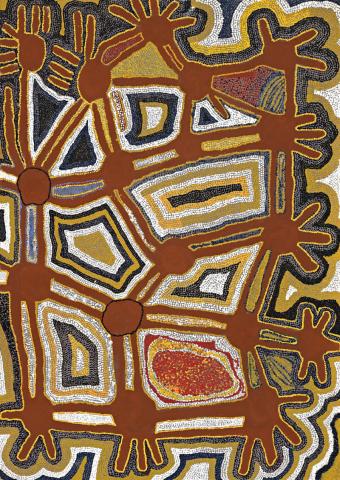MINGATJURU WARTALARRI, 1990
WIMMITJI TJAPANGARTI
synthetic polymer paint on canvas
119.5 x 84.5 cm
inscribed verso: artist's name, size and Warlayirti Artists cat. 155/90
Warlayirti Artists, Balgo Hills
Gallery Gabrielle Pizzi, Melbourne (label attached verso)
Private collection, Melbourne
This work is accompanied by a copy of the original Warlayirti artists certificate.
The art of Balgo Hills emanates from one of the driest, most remote parts of Australia. Wedged between the Gibson and Tanami deserts and the Great Sandy Desert, it is an area of immense cultural and spiritual significance to the Gugadja people. From such arid environs one of the most dynamic indigenous art forms has evolved. Gugadja painting all springs from the traditional practices of body and sand painting and is ultimately a deeply sacred activity. Wimmitji Tjapangarti has been rightfully referred to as a Master Balgo painter.1 He began painting his country in 1987 when the arts community was in its infancy and he was one of the earliest artists to move deftly from the use of traditional ochres and pigments to synthetic polymer paint. This development revolutionised art practice in the area and created a distinctive style of which Wimmitji Tjapangarti may be regarded as a pioneer.
Wimmitji Tjapangarti understood his country intimately and was the custodian of numerous Tingari dreamings. The narrative which underpins Mingatjuru Wartalarri would have originally been expressed in the sand. It is the story of Tingari creatures which left their marks in the sandy hills around Nyinmi, near Jupiter Well. Two small marsupials dug holes in the ground which can be seen in the daisy wheel roundels along the periphery of the painting. From these holes sprang 'kurrkarpt' or desert oaks, which produce an important flower that is sucked for its sweet nectar. The concentric lined shapes in the centre of this work also have their genesis in sand paintings depicting clouds, and the red circle in the lower right corner represents Nyintjitti Hill.2
1. Cowan, J., Wirrimanu: Aboriginal Art from the Balgo Hills, Roseville, 1994, p. 11
2. Taken from the notes and diagram included in the original Warlayirti Artists certificate no.155/90
LARA NICHOLLS
